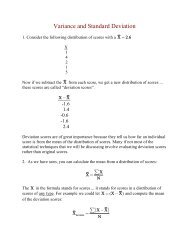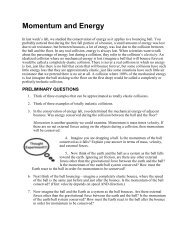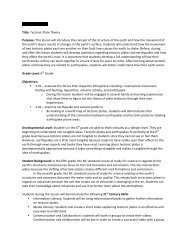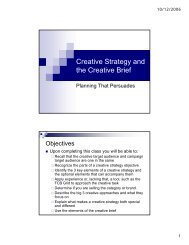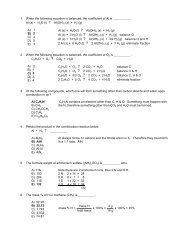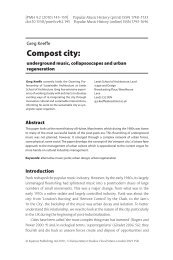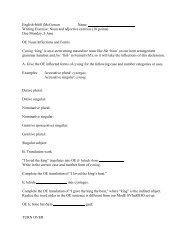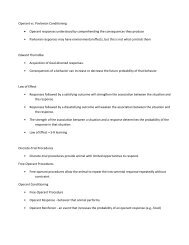1. If the pressure of a sample of gas with a constant number of moles ...
1. If the pressure of a sample of gas with a constant number of moles ...
1. If the pressure of a sample of gas with a constant number of moles ...
Create successful ePaper yourself
Turn your PDF publications into a flip-book with our unique Google optimized e-Paper software.
<strong>1.</strong> <strong>If</strong> <strong>the</strong> <strong>pressure</strong> <strong>of</strong> a <strong>sample</strong> <strong>of</strong> <strong>gas</strong> <strong>with</strong> a <strong>constant</strong> <strong>number</strong> <strong>of</strong> <strong>moles</strong> is quadrupled and <strong>the</strong> absolute temperature is doubled, by<br />
what factor does <strong>the</strong> volume <strong>of</strong> <strong>the</strong> <strong>sample</strong> change<br />
A. 8<br />
B. 2<br />
C. 1/2<br />
D. 1/4<br />
E. 1/8<br />
nRT<br />
V = after P is quadrupled and t is doubled we get:<br />
P<br />
nR ⋅ 2T<br />
V = . Thus V is increased by 2/4 or 1/2.<br />
4P<br />
2. <strong>If</strong> <strong>the</strong> <strong>pressure</strong> on a <strong>sample</strong> <strong>of</strong> <strong>gas</strong> (<strong>constant</strong> <strong>number</strong> <strong>of</strong> <strong>moles</strong>) is tripled and <strong>the</strong> absolute temperature is quadrupled, by what<br />
factor will <strong>the</strong> volume <strong>of</strong> <strong>the</strong> <strong>sample</strong> change<br />
A. 12<br />
B. 3/4<br />
C. 4/3<br />
D. 1/3<br />
E. 4<br />
nRT<br />
V = after P tripled P and T is quadrupled, we get:<br />
P<br />
nR ⋅ 4T<br />
V = . Thus V is increased by 4/3.<br />
3P<br />
3. A small bubble rises from <strong>the</strong> bottom <strong>of</strong> a lake, where <strong>the</strong> temperature and <strong>pressure</strong> are 4°C and 3.0 atm, to <strong>the</strong> water's<br />
surface, where <strong>the</strong> temperature is 25°C and <strong>pressure</strong> is 0.95 atm. Calculate <strong>the</strong> final volume <strong>of</strong> <strong>the</strong> bubble if its initial volume<br />
was 2.1 mL.<br />
A. 0.72 mL<br />
B. 6.2 mL<br />
C. 7.1 mL<br />
D. 22.4 mL<br />
E. 4<strong>1.</strong>4 mL<br />
P V1<br />
P2V2<br />
(3.0 atm)(2.1mL) (0.95 atm)(V2<br />
= nR = ⇒<br />
= nR =<br />
T T<br />
277 K<br />
298 K<br />
1 )<br />
1<br />
V 2 = 7.1 mL<br />
2<br />
4. Calculate <strong>the</strong> volume occupied by 35.2 g <strong>of</strong> methane <strong>gas</strong> (CH 4 , 0=16.0 g/mol.) at 25°C and <strong>1.</strong>0 atm.<br />
(R = 0.0821 Latm/Kmol.)<br />
A. 0.0186 L<br />
B. 4.5 L<br />
C. 1<strong>1.</strong>2 L<br />
D. 49.2 L<br />
E. 53.7 L<br />
1mol.<br />
n = 35.2 g x = 2.19 mol.<br />
16.0 g<br />
nRT (2.19 mol.)(0.0821L ⋅ atm/mol ⋅ K)(298 K)<br />
V = =<br />
= 53.7 L<br />
P<br />
1atm<br />
5. Calculate <strong>the</strong> density in g/L <strong>of</strong> chlorine <strong>gas</strong> at STP.<br />
A. 2.13 x 10 -2 g/L<br />
B. 46.9 g/L<br />
C. <strong>1.</strong>58 g/L<br />
D. 3.16 g/L<br />
E. 0.316 kg/L<br />
RT (0.0821L ⋅ atm/mol ⋅ K)(273K)<br />
n = =<br />
= 0.0446 mol.<br />
PV<br />
(1atm)(1L)<br />
70.9 g<br />
mass = 0.0446 mol. x = 3.16 g d = 3.16 g / 1 L = 3.16 g/L<br />
1mol.<br />
6. Which <strong>of</strong> <strong>the</strong> following <strong>gas</strong>es will have <strong>the</strong> greatest density when <strong>the</strong>y are all compared at <strong>the</strong> same temperature and<br />
<strong>pressure</strong><br />
A. H 2<br />
<strong>If</strong> <strong>the</strong>y are all at <strong>the</strong> same temperature and <strong>pressure</strong>, <strong>the</strong>n <strong>the</strong> <strong>moles</strong> per liter will also be <strong>the</strong><br />
B. CClF 3<br />
same for all <strong>the</strong> <strong>gas</strong>es. Consequently, <strong>the</strong> <strong>gas</strong> <strong>with</strong> <strong>the</strong> greatest density (g/L) will be <strong>the</strong> <strong>gas</strong><br />
C. CO 2<br />
D. C 2 H 6<br />
<strong>with</strong> <strong>the</strong> greatest molar mass, which is CClF 3<br />
E. CF 4
7. Two <strong>moles</strong> <strong>of</strong> chlorine <strong>gas</strong> at 20.0°C are heated to 350°C while <strong>the</strong> volume is kept <strong>constant</strong>. The density <strong>of</strong> <strong>the</strong> <strong>gas</strong><br />
A. increases.<br />
Density is g/L. Since both <strong>moles</strong> (thus mass) and <strong>the</strong> volume are <strong>constant</strong>, <strong>the</strong> density<br />
B. decreases.<br />
must also be <strong>constant</strong>.<br />
C. remains <strong>the</strong> same.<br />
D. not enough information given to correctly answer <strong>the</strong> question<br />
8. A <strong>sample</strong> <strong>of</strong> unknown <strong>gas</strong> weighing 5.02 g is sealed in a <strong>1.</strong>0 L flask at 37°C and 3.75 atm. Which one <strong>of</strong> <strong>the</strong> following is<br />
most likely to be <strong>the</strong> unknown<br />
mol.<br />
A. H 2 O<br />
RT (0.0821L ⋅atm/mol<br />
⋅ K)(310 K)<br />
B. HBr<br />
n = =<br />
= 0.147<br />
PV (3.75 atm)(1L)<br />
C. HCN<br />
E. C 2 H 2<br />
D. H 2 S<br />
0 = 5.02 g / 0.147 mol. = 34.1 g/mol. This is <strong>the</strong> molar mass <strong>of</strong> H 2 S.<br />
9. A mixture <strong>of</strong> three <strong>gas</strong>es has a total <strong>pressure</strong> <strong>of</strong> 1,380 mmHg at 298 K. The mixture is analyzed and is found to contain <strong>1.</strong>27<br />
mol CO 2 , 3.04 mol CO, and <strong>1.</strong>50 mol Ar. What is <strong>the</strong> partial <strong>pressure</strong> <strong>of</strong> Ar<br />
A. 0.258 atm<br />
B. 301 mmHg<br />
C. 356 mmHg<br />
D. 5,345 mmHg<br />
E. 8,020 mmHg<br />
χ<br />
mol.<br />
=<br />
mol.<br />
<strong>1.</strong><br />
50<br />
=<br />
<strong>1.</strong>27 + 3.04 + <strong>1.</strong>50<br />
Ar<br />
Ar<br />
=<br />
total<br />
0.258<br />
P Ar = χ Ar·PT = (0.258)(1380 mmHg) = 356 mmHg<br />
10. What volume <strong>of</strong> oxygen <strong>gas</strong> at 320 K and 680 torr will react <strong>with</strong> 2.50 L <strong>of</strong> NO <strong>gas</strong> at <strong>the</strong> same temperature and <strong>pressure</strong><br />
2NO(g) + O 2 (g) → 2NO 2 (g)<br />
A. <strong>1.</strong>25 L<br />
B. 2.50 L<br />
C. 3.00 L<br />
D. <strong>1.</strong>00 L<br />
E. 5.00 L<br />
n<br />
RT V<br />
= =<br />
P n<br />
VNO<br />
O2 O2<br />
NO<br />
VO 2<br />
=<br />
<strong>1.</strong>25 L<br />
O2<br />
2.50 L V<br />
⇒ =<br />
2 mol. 1mol.<br />
1<strong>1.</strong> What mass <strong>of</strong> KClO 3 (0 = 122 g/mol.) must be decomposed to produce 126 L <strong>of</strong> oxygen <strong>gas</strong> at 133°C and 0.880 atm<br />
2KClO 3 (s) → 2KCl (s) + 3O 2 (g)<br />
A. 24.6 g<br />
B. 70.8 g<br />
C. 272 g<br />
D. 408 g<br />
E. 612 g<br />
RT (0.0821L ⋅atm/mol<br />
⋅K)(406 K)<br />
n = =<br />
= 3.33 mol.O 2<br />
PV (0.880 atm)(126 L)<br />
2 mol. KClO3<br />
122 g<br />
3.33 mol.O 2 x<br />
x = 272 g KClO3<br />
3 mol.O 1mol.<br />
2<br />
12. <strong>If</strong> equal masses <strong>of</strong> O 2 (g) and HBr (g) are in separate containers <strong>of</strong> equal volume and temperature, which one <strong>of</strong> <strong>the</strong> following<br />
statements is true<br />
A. The <strong>pressure</strong> in <strong>the</strong> O 2 container is greater than that in <strong>the</strong> HBr container.<br />
B. There are more HBr molecules than O 2 molecules.<br />
C. The average kinetic energy <strong>of</strong> O 2 molecules is greater than that <strong>of</strong> HBr molecules.<br />
D. The average kinetic energy <strong>of</strong> HBr molecules is greater than that <strong>of</strong> O 2 molecules.<br />
E. The <strong>pressure</strong>s <strong>of</strong> both <strong>gas</strong>es are <strong>the</strong> same.<br />
P<br />
n<br />
O2<br />
O2<br />
RT P<br />
= =<br />
V n<br />
HBr<br />
HBr<br />
Since <strong>the</strong>re are equal masses <strong>of</strong> each <strong>gas</strong>, <strong>the</strong>re must be more <strong>moles</strong> <strong>of</strong> O 2 than HBr, which<br />
means that <strong>the</strong> <strong>pressure</strong> <strong>of</strong> <strong>the</strong> O 2 must also be greater.
13. Which <strong>gas</strong> has molecules <strong>with</strong> <strong>the</strong> greatest average molecular speed at 25°C<br />
A. CH 4<br />
B. Kr<br />
C. N 2<br />
D. CO 2<br />
E. Ar<br />
Kinetic energy will be <strong>the</strong> same for all molecules since <strong>the</strong>y are at <strong>the</strong> same temperature.<br />
Since kinetic energy = ½(mass)(speed) 2 , lighter molecules must have greater speeds.<br />
14. In which <strong>of</strong> <strong>the</strong> following <strong>gas</strong>es do molecules have <strong>the</strong> highest average kinetic energy at 25°C<br />
A. H 2<br />
B. O 2<br />
C. N 2<br />
D. Cl 2<br />
E. all have <strong>the</strong> same<br />
Kinetic energy is <strong>the</strong> same for all molecules at <strong>the</strong> same temperature.<br />
15. For a substance that remains a <strong>gas</strong> under <strong>the</strong> conditions listed, deviation from <strong>the</strong> ideal <strong>gas</strong> law would be most pronounced at<br />
A. 100°C and 2.0 atm.<br />
B. 0°C and 2.0 atm.<br />
C. -100°C and 2.0 atm.<br />
D. -100°C and 4.0 atm.<br />
E. 100°C and 4.0 atm.<br />
Gases deviate from ideal behavior at lower temperatures and higher <strong>pressure</strong>s since<br />
IMF's and molecular (and atomic) volumes become significant.<br />
16. Helium atoms do not combine to form He 2 molecules, yet He atoms do attract one ano<strong>the</strong>r weakly through<br />
A. dipole-dipole forces.<br />
B. ion-dipole forces.<br />
C. dispersion forces.<br />
D. dipole-induced dipole forces.<br />
E. hydrogen bonding.<br />
17. Which one <strong>of</strong> <strong>the</strong> following substances should exhibit hydrogen bonding in <strong>the</strong> liquid state<br />
A. PH 3<br />
B. H 2<br />
C. H 2 S<br />
D. CH 4<br />
E. NH 3<br />
Hydrogen bonding requires H bonded to ei<strong>the</strong>r N, O or F.<br />
18. Which <strong>of</strong> <strong>the</strong> following should have <strong>the</strong> highest boiling point<br />
A. CH 4<br />
All <strong>the</strong> molecules have dispersion forces; only CH 3 Cl has dipole interactions as well.<br />
B. Cl 2<br />
Thus CH<br />
C. Kr<br />
3 Cl will have <strong>the</strong> strongest intermolecular forces and <strong>the</strong> highest boiling point.<br />
D. CH 3 Cl<br />
E. N 2<br />
19. Which <strong>of</strong> <strong>the</strong> following liquids would have <strong>the</strong> highest viscosity at <strong>the</strong> same temperature<br />
A. CH 3 OCH 3<br />
B. CH 2 Cl 2<br />
C. C 2 H 5 OH<br />
D. CH 3 Br<br />
E. HOCH 2 CH 2 OH<br />
All <strong>the</strong> molecules have dispersion and dipoles forces. In addition, C 2 H 5 OH and<br />
HOCH 2 CH 2 OH have hydrogen bonding. HOCH 2 CH 2 OH is capable <strong>of</strong> hydrogen<br />
bonding through both OH groups and will thus have <strong>the</strong> strongest intermolecular forces<br />
and <strong>the</strong> highest viscosity.
20. Each <strong>of</strong> <strong>the</strong> following substances is a liquid at -50°C. Place <strong>the</strong>se liquids in order <strong>of</strong> increasing vapor <strong>pressure</strong>.<br />
H H<br />
H H<br />
H H H<br />
H C O C H H C C OH H C C C<br />
H H<br />
H H<br />
H H H<br />
dimethyl e<strong>the</strong>r ethanol propane<br />
H<br />
A. ethanol < propane < dimethyl e<strong>the</strong>r<br />
B. ethanol < dimethyl e<strong>the</strong>r < propane<br />
C. propane < dimethyl e<strong>the</strong>r < ethanol<br />
D. dimethyl e<strong>the</strong>r < ethanol < propane<br />
E. propane < ethanol < dimethyl e<strong>the</strong>r<br />
Vapor <strong>pressure</strong> depends on <strong>the</strong> facility by which a molecule can leave <strong>the</strong><br />
liquid and become a <strong>gas</strong>. The more easily this occurs, <strong>the</strong> higher <strong>the</strong><br />
resulting vapor <strong>pressure</strong>. For this process to be facile, <strong>the</strong> intermolecular<br />
forces must be weak. Propane, <strong>with</strong> only dispersion forces, will have <strong>the</strong><br />
weakest IMF's. Ethanol, <strong>with</strong> H-bonding, will have <strong>the</strong> strongest IMF's.<br />
2<strong>1.</strong> Arrange <strong>the</strong> following in order <strong>of</strong> increasing boiling point: RbCl, CH 3 Cl, CH 3 OH, CH 4 .<br />
A. CH 3 OH < CH 3 Cl < RbCl < CH 4<br />
B. CH 3 OH < CH 4 < CH 3 Cl < RbCl<br />
C. RbCl < CH 3 Cl < CH 3 OH < CH 4<br />
D. CH 4 < CH 3 OH < CH 3 Cl < RbCl<br />
E. CH 4 < CH 3 Cl < CH 3 OH < RbCl<br />
RbCl is an ionic solid and would consequently have a higher boiling point than<br />
<strong>the</strong> three molecular solids. The three would be ordered by IMF's.<br />
CH 3 OH: H-bonding, dipole, dispersion<br />
CH 3 Cl: dipole, dispersion<br />
CH 4 : dispersion<br />
22. Which one <strong>of</strong> <strong>the</strong> following substances would exhibit hydrogen bonding in <strong>the</strong> liquid state<br />
A. SiH 4<br />
B. H 2<br />
C. H 2 S<br />
D. CH 4<br />
E. CH 3 NH 2<br />
Hydrogen bonding requires H bonded to ei<strong>the</strong>r N, O or F.<br />
23. Which one <strong>of</strong> <strong>the</strong> following crystallizes in a metallic lattice<br />
A. C (graphite)<br />
B. NaMnO 4<br />
C. K As <strong>the</strong> only metal, K will crystallize in a metallic lattice<br />
D. LiClO 4<br />
E. K 2 Cr 2 O 7<br />
24. A liquid boils when its<br />
A. vapor <strong>pressure</strong> is exactly 1 atmosphere.<br />
B. vapor <strong>pressure</strong> is equal to, or greater than, <strong>the</strong> external <strong>pressure</strong> pushing on it.<br />
C. temperature is equal to 273 K (standard temperature).<br />
D. temperature is greater than room temperature.<br />
25. Which <strong>of</strong> <strong>the</strong> following is not an endo<strong>the</strong>rmic process<br />
A. melting <strong>of</strong> a solid<br />
B. vaporization<br />
C. raising <strong>the</strong> temperature <strong>of</strong> a <strong>gas</strong><br />
D. condensation <strong>of</strong> water vapor<br />
E. sublimation <strong>of</strong> dry ice<br />
All <strong>the</strong> processes except for condensation require that energy be put into<br />
<strong>the</strong> system, that heat be added, and are thus endo<strong>the</strong>rmic. Only<br />
condensation give <strong>of</strong>f energy (put ano<strong>the</strong>r way: is facilitated by cooling)<br />
and is <strong>the</strong>refore exo<strong>the</strong>rmic.
B<br />
(s)<br />
(")<br />
P (mm Hg)<br />
(g)<br />
90<br />
A<br />
28<br />
27<br />
75<br />
114<br />
T (°C)<br />
535<br />
26. In <strong>the</strong> phase diagram <strong>of</strong> I 2 , <strong>the</strong> point represented by A is <strong>the</strong><br />
A. boiling point.<br />
B. critical point.<br />
C. melting point.<br />
D. sublimation point.<br />
E. triple point.<br />
27. What is <strong>the</strong> phase <strong>of</strong> I 2 at 80 mmHg and 200°C<br />
A. <strong>gas</strong><br />
B. liquid<br />
C. solid<br />
D. super critical fluid<br />
E. Bose-Einstein condensate<br />
28. <strong>If</strong> I 2 at 85 mmHg and 150°C is cooled to 75°C (still 85 mmHg), what phase change would occur<br />
A. Condensation<br />
B. Deposition<br />
C. Freezing<br />
D. Sublimation<br />
E. No phase change would occur.
temperature<br />
2 3<br />
4<br />
5<br />
1<br />
time<br />
29. The graph above represents <strong>the</strong> heating <strong>of</strong> a piece <strong>of</strong> solid potassium over time. The region labeled 2 represents<br />
A. vaporization <strong>of</strong> <strong>the</strong> liquid phase.<br />
B. heating <strong>of</strong> <strong>the</strong> solid phase.<br />
C. heating <strong>of</strong> <strong>the</strong> liquid phase.<br />
D. heating <strong>of</strong> <strong>the</strong> <strong>gas</strong> phase.<br />
E. melting <strong>of</strong> <strong>the</strong> solid phase.<br />
30. The graph above represents <strong>the</strong> heating <strong>of</strong> a piece <strong>of</strong> solid potassium over time. The region labeled 5 represents<br />
A. vaporization <strong>of</strong> <strong>the</strong> liquid phase.<br />
B. heating <strong>of</strong> <strong>the</strong> solid phase.<br />
C. heating <strong>of</strong> <strong>the</strong> liquid phase.<br />
D. heating <strong>of</strong> <strong>the</strong> <strong>gas</strong> phase.<br />
E. melting <strong>of</strong> <strong>the</strong> solid phase.



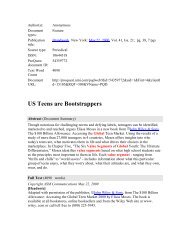

![Graduate Bulletin [PDF] - MFC home page - Appalachian State ...](https://img.yumpu.com/50706615/1/190x245/graduate-bulletin-pdf-mfc-home-page-appalachian-state-.jpg?quality=85)
